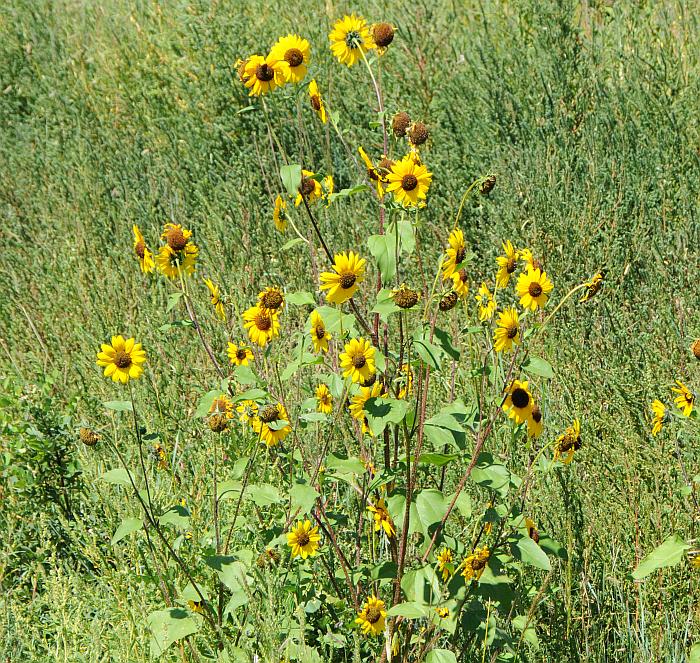Helianthus annuus L.
Common Sunflower

Native
CC = 0
CW = 3
MOC = 45
© SRTurner
Helianthus annuus L.Common Sunflower | |
 |
Native CC = 0 CW = 3 MOC = 45 |
© SRTurner |
|
Family - Asteraceae/Heliantheae Habit - Taprooted annual forb. Stems - Erect, solitary, to 3 m, stout, moderately pubescent with short, stiff, ascending, pustular-based hairs, these often breaking off toward the stem base, leaving the persistent expanded base.
Leaves - Mostly alternate, simple, long-petiolate, well developed along the stem (usually with 8-25 nodes). Blades of the stem leaves 7-40 cm long, 3-35 cm wide, ovate to triangular-ovate (mostly 1.2-2.5 times as long as wide), flat or sometimes slightly drooping, cordate to truncate, broadly rounded, or short-tapered at the base, tapered to a usually sharply pointed tip, the margins finely to coarsely and often somewhat irregularly toothed, flat, the surfaces moderately to densely roughened, pubescent with minute, loosely appressed, pustular-based hairs, also with moderate to dense, sessile, yellow glands, usually with 3 main veins, the lateral pair branching from the midnerve at the base of the blade.
Inflorescence - Usually appearing as open panicles of heads, less commonly as solitary terminal heads.
Heads - Involucre 10-30 mm long, 20-50 mm in diameter, the bracts in 3 or 4 somewhat unequal series, narrowly ovate to ovate, tapered to a sharply pointed, slender, loosely ascending to more commonly spreading or recurved tip, the margins with relatively long, stiff, spreading hairs, the outer surface moderately to densely pubescent with stiff, loosely ascending to spreading, pustular-based hairs, both surfaces also usually with small, sessile, yellow glands. Receptacle flat or slightly convex, the chaffy bracts 9-12 mm long, narrowly oblong-triangular, usually 3-lobed above the midpoint, the lobes tapered to sharply pointed, straw-colored to dark purple, inconspicuously short-hairy tips which lack white hairs, the outer surface usually glabrous below the tip.
Flowers - Ray florets 17-40, the corolla 2.5-5.0 cm long, variously glabrous or both surfaces inconspicuously hairy toward the base, or the outer surface minutely hairy and occasionally also with minute, sessile, yellow glands. Disc florets with the corolla 5-8 mm long, reddish brown to dark purple (at least the lobes and the upper portion of the tube). Pappus of 2 scales 2.0-3.5 mm long, these narrowly lanceolate-triangular, tapered to a sharply pointed, often minutely awnlike tip, papery, often also with 1-4 additional oblong scales 0.2-1.0 mm long.
Fruits - Achenes 3-7 mm long, narrowly wedge-shaped to obovate, flattened but usually more or less 4-angled in cross-section, the surface glabrous or more commonly densely and minutely hairy when young, but usually appearing glabrous or nearly so at maturity, uniformly black to variously with gray, brown, or white stripes or mottling. Flowering - July - November. Habitat - Upland prairies, forest openings, streambanks, fields, ditches, railroads, roadsides, open disturbed areas. Modified forms are widely cultivated. Origin - Native to the U.S. Lookalikes - Other species of Helianthus, particularly H. petiolaris. More broadly, it resembles numerous other plants in the aster family. Other info. - This plant is the wild type of the cultivated "sunflower seed," grown extensively for birdseed, sunflower oil, and the edible sunflower seeds widely consumed by humans and baseball players. It is found in Missouri mostly toward the western half of the state, and indeed it is far more common to our west. Its native range encompasses the western half of the continental U.S. It is the state flower of Kansas, where the plants are a common sight. The plant is recognized by its large composite heads with dark disks, tall stature, and broad leaves with long petioles. It can be differentiated from H. petiolaris by the lack of white hairs on the chaffy bracts of the disk and by longer, spreading hairs on the involucral bracts. It is also typically larger than that species, although size can depend on conditions.
Photographs taken at the Peck Ranch Wildlife Refuge, Carter County, MO., 7-12-03 (DETenaglia); also at Busch Wildlife Area, St. Charles County, MO, 7-13-2008, along roadsides in Wabaunsee County, KS, 8-28-2013, Sherman County, KS, 8-29-2013, El Paso County, CO, 8-29-2013, and Niobrara County, WY, 7-15-2021, and at Marais Temps Clair Conservation Area, St. Charles County, MO, 9-1-2022 (SRTurner). |